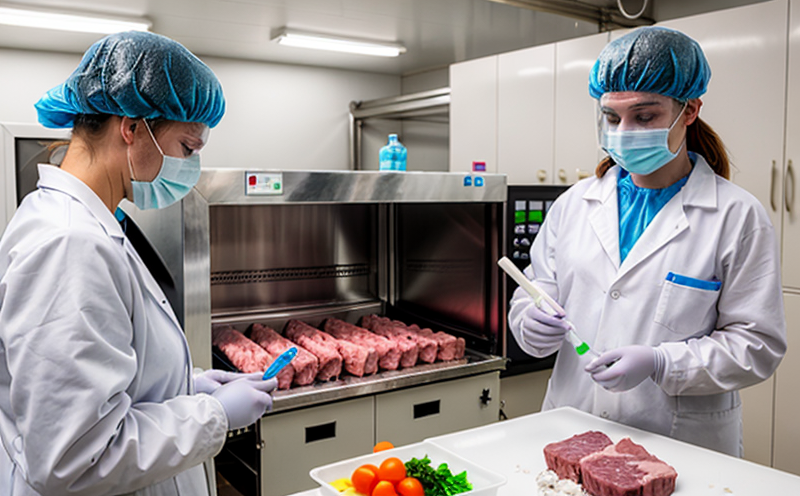ASTM E2562 Rapid Microbial Testing of Dairy Products
The rapid microbial testing procedure as described in ASTM E2562 is a cornerstone for ensuring the quality and safety of dairy products. This test measures the total viable count (TVC) of microorganisms in raw milk or pasteurized dairy products, providing quick results to help maintain product integrity. Rapid microbial testing is essential in the dairy sector where timely decisions are critical to prevent contamination and spoilage.
The ASTM E2562 method utilizes a combination of sample dilution techniques, plating methods, and incubation periods optimized for different types of dairy products. This ensures that any potential pathogenic or spoilage microorganisms are detected accurately within the shortest possible time frame. The testing process is designed to be precise, efficient, and reproducible.
For quality managers in dairy processing plants, this test offers a valuable tool to monitor raw material intake and final product release. By integrating ASTM E2562 into their quality assurance programs, they can ensure that only the highest-quality raw milk or pasteurized products reach their customers. This not only enhances consumer confidence but also helps in maintaining compliance with international standards.
The procedure is particularly useful for detecting spoilage and pathogenic bacteria such as Listeria monocytogenes, which can have serious health implications if present in dairy products. By incorporating ASTM E2562 into their testing protocols, dairy manufacturers can ensure that any contamination or spoilage issues are identified promptly, allowing them to take corrective actions swiftly.
ASTM E2562 also supports the research and development (R&D) teams by providing reliable data for product formulation, ingredient selection, and process optimization. The quick turnaround time of this test allows R&D engineers to iterate on their experiments more rapidly, leading to faster innovation cycles in dairy product development.
In summary, ASTM E2562 is a critical tool in the dairy industry that supports both quality assurance and research efforts. Its ability to provide rapid results makes it an indispensable part of any comprehensive microbiological testing program for dairy products.
Scope and Methodology
| Sample Preparation: | The sample is first diluted using a serial dilution technique to ensure that the microorganisms are within the detectable range of the plating method. This involves pipetting an aliquot of the sample into a nutrient agar plate, followed by additional dilutions as necessary. |
|---|---|
| Plating: | A standard pour or spread plating method is used to inoculate the diluted sample onto nutrient agar plates containing selective media appropriate for the suspected microorganisms. This allows for the isolation and enumeration of viable colonies. |
| Inoculation: | The inoculated plates are incubated under controlled conditions, typically at 30°C to 45°C depending on the type of microorganism being tested. The incubation period is optimized for each specific dairy product, ensuring that all viable cells have time to grow into visible colonies. |
| Counting: | The number of colonies is counted after a specified incubation period. This count represents the total viable count (TVC) of microorganisms in the original sample. The results are reported as colony-forming units per milliliter (CFU/mL). |
ASTM E2562 provides detailed instructions for each step, ensuring that the testing process is both standardized and reproducible across different laboratories.
Industry Applications
| Dairy Processing: | The ASTM E2562 method is widely used in dairy processing plants to monitor raw milk intake. By testing for total viable counts, processors can ensure that the incoming milk meets quality standards and is free from contamination. |
|---|---|
| Quality Assurance: | This test is also crucial in ensuring product consistency and safety during production. It helps identify any potential issues early on, allowing corrective actions to be taken promptly. |
| R&D Support: | In the R&D phase of new dairy products, ASTM E2562 can provide critical data for ingredient selection and process optimization. The rapid results allow for quick iterations in product development cycles. |
The flexibility of ASTM E2562 makes it applicable across various stages of the dairy production lifecycle, from raw material intake to final product quality assurance.
Competitive Advantage and Market Impact
- Faster decision-making: The rapid nature of ASTM E2562 allows for quicker identification of issues, enabling faster corrective actions.
- Better product quality: By ensuring that only high-quality raw materials are used in production, this test enhances the overall quality of dairy products.
- Enhanced consumer trust: Consistent adherence to international standards like ASTM E2562 builds confidence among consumers regarding the safety and reliability of dairy products.
The implementation of ASTM E2562 can give companies a significant edge in the market, differentiating them through superior product quality and reliability. This is particularly important in the competitive dairy sector where maintaining high standards is crucial for success.





